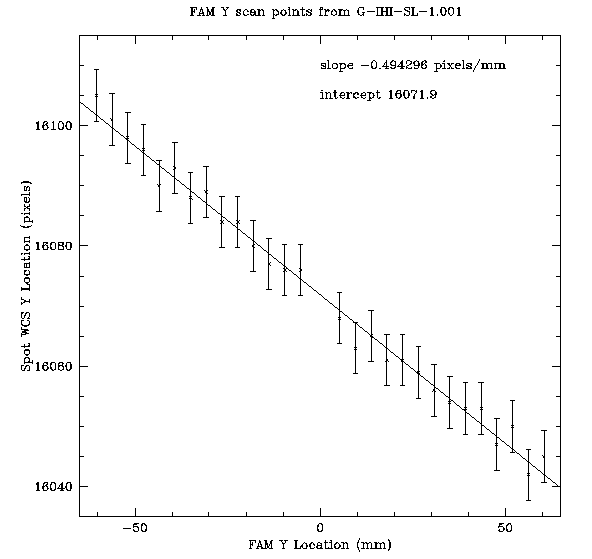HRC-I Spatial Linearity Test G-IHI-SL-1.001 and the FAM Step Size
At the AXAF Calibration Workshop (1997 August 20-21) both the ACIS and
HETG teams reported test results that suggested that the FAM step
sizes were not as reported. The spatial linearity tests that were
performed with the HRC-I provide an ideal check on whether the
reported FAM motions are accurate since the range of travel was
approximately 120 mm. I have performed an analysis using the event
list from the test G-IHI-SL-1.001 and find that the reported FAM step
size is less than 0.1 % off. This analysis also provides a
determination of the roll orientation of the HRC-I about the optic
axis.
The HRC-I spatial linearity test used the FAM to move the HRC so that the
optic axis pointed at several discrete locations, separated by ~4.2
mm, along both the Y-axis and Z-axis diagonals. A heavier sampling of
points was made in the center of the detector. The large range in
motion along the detector diagonal and excellent spatial resolution of
the HRC make the detection of an incorrect step straightforward.
The data used for this analysis were the event list and FAM location
file generated by the ASCDS pipelines shortly after the data were
taken back in March. The files are located in the directory on the SAO
network:
/data/prod2/pipe/970325/G-IHI-SL-1.001/i001/hrcl1/out/.
I used the FAM locations file to select time intervals for each of the
stationary points in the scan along the Y axis that were outside of
the heavily sampled central area. The centroid of each x-ray spot was
found in the WCS system; these positions have had the FAM motion
correction included so that we would expect all the spots to have the
same location. An inaccurate step size for FAM travel along the Y axis
would cause the WCS "X" locations to "drift" away from each other as
the FAM distance increases. Figure 1 shows the WCS
"X" locations for each of the FAM locations along the Y axis. There is
a slight positive slope implying that the reported step size is too
small by 0.063 %, much smaller than the discrepancies reported by the
ACIS and HETG teams. Figure 2 is a similar plot
for the image locations along the axis perpendicular to the direction
of motion. The significant slope in this case implies that the motion
correction does not include a roll misalignment for the HRC-I about
the optic axis. From the slope of the least squares fit I find a
misalignment angle of 10.6 arcmin.
A similar result can be derived from the Z-axis scan. Fewer of the
discrete points can be used however as there appears to have been a
problem with the IRIG time stamps during the latter part of this
test.

Figure 1 Mean WCS "X" location (position on XRCF Y axis) of the
on-axis x-ray image as a function of FAM Y position (stf_y). Only
times when the FAM was reported as stationary were used. The pixels
are 1/8 arcsec, which corresponds to 6.217 microns. The least squares
fit slope of 0.101209 pixels/mm translates to 0.00063 mm/mm correction
in event location.

Figure 2 Similar to figure 1 but for the mean WCS "Y" location
as a function of FAM Y position. The significant slope in this case
implies that the motion correction does not include a roll
misalignment for the HRC-I of ~10.6 arcmin.
Dr. Michael Juda
Harvard-Smithsonian Center for Astrophysics
60 Garden Street, Mail Stop 70
Cambridge, MA 02138, USA
Ph.: (617) 495-7062
Fax: (617) 495-7356
E-mail:
mjuda@cfa.harvard.edu


